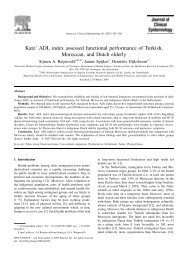Effects of Amlodipine and Lisinopril on Left Ventricular Mass ... - share
Effects of Amlodipine and Lisinopril on Left Ventricular Mass ... - share
Effects of Amlodipine and Lisinopril on Left Ventricular Mass ... - share
You also want an ePaper? Increase the reach of your titles
YUMPU automatically turns print PDFs into web optimized ePapers that Google loves.
110 F. W. Beltman et al.Besides measurement <str<strong>on</strong>g>of</str<strong>on</strong>g> left ventricular mass, Dopplerechocardiography is <str<strong>on</strong>g>of</str<strong>on</strong>g>ten used to measure diastolicfilling abnormalities n<strong>on</strong>-invasively in assessing diastolicdysfuncti<strong>on</strong>. This is a comm<strong>on</strong> abnormality in mild toearly hypertensi<strong>on</strong>. Diastolic dysfuncti<strong>on</strong> is frequentlyseen in the presence <str<strong>on</strong>g>of</str<strong>on</strong>g> left ventricular hypertrophy, butthis may also occur independently <str<strong>on</strong>g>of</str<strong>on</strong>g> the hypertrophicprocess [12]. L<strong>on</strong>g-term treatment <str<strong>on</strong>g>of</str<strong>on</strong>g> hypertensi<strong>on</strong> hasbeen shown to improve diastolic functi<strong>on</strong>, even in theabsence <str<strong>on</strong>g>of</str<strong>on</strong>g> left ventricular hypertrophy. In general, thedata suggest a beneficial effect <str<strong>on</strong>g>of</str<strong>on</strong>g> calcium antag<strong>on</strong>ists <str<strong>on</strong>g>and</str<strong>on</strong>g>ACE inhibitors, but not <str<strong>on</strong>g>of</str<strong>on</strong>g> beta-blockers or diuretics [12].The primary objective <str<strong>on</strong>g>of</str<strong>on</strong>g> this 1-year prospective,double-blind, r<str<strong>on</strong>g>and</str<strong>on</strong>g>omized, parallel group, comparativestudy was to compare the effects <str<strong>on</strong>g>of</str<strong>on</strong>g> two l<strong>on</strong>g-actingantihypertensive agents, the calcium-antag<strong>on</strong>ist amlodipine<str<strong>on</strong>g>and</str<strong>on</strong>g> the ACE inhibitor lisinopril, <strong>on</strong> left ventricularmass <str<strong>on</strong>g>and</str<strong>on</strong>g> diastolic filling in patients with mild tomoderate diastolic hypertensi<strong>on</strong>. Sec<strong>on</strong>dary objectiveswere comparis<strong>on</strong> <str<strong>on</strong>g>of</str<strong>on</strong>g> antihypertensive efficacy, safety <str<strong>on</strong>g>and</str<strong>on</strong>g>tolerability <str<strong>on</strong>g>of</str<strong>on</strong>g> both drugs.METHODSPatient selecti<strong>on</strong>Untreated, newly diagnosed patients with diastolichypertensi<strong>on</strong> were recruited from a populati<strong>on</strong> survey.Blood pressure was measured in the sitting positi<strong>on</strong> after5 min <str<strong>on</strong>g>of</str<strong>on</strong>g> rest using the right arm. Systolic (SBP) <str<strong>on</strong>g>and</str<strong>on</strong>g>diastolic (DBP) blood pressure were recorded at Korotk<str<strong>on</strong>g>of</str<strong>on</strong>g>fphases I <str<strong>on</strong>g>and</str<strong>on</strong>g> V at the nearest 2 mmHg. If a differencein blood pressure was found between both arms (>5/10 mmHg for DBP <str<strong>on</strong>g>and</str<strong>on</strong>g> SBP, respectively), the <strong>on</strong>e withthe highest blood pressure was used for further measurement.Both male <str<strong>on</strong>g>and</str<strong>on</strong>g> female patients with diastolichypertensi<strong>on</strong> (DBP 95 mmHg <strong>on</strong> three different occasi<strong>on</strong>s,e.g. twice <strong>on</strong> the first occasi<strong>on</strong> <str<strong>on</strong>g>and</str<strong>on</strong>g> <strong>on</strong>ce <strong>on</strong> thesec<strong>on</strong>d <str<strong>on</strong>g>and</str<strong>on</strong>g> third occasi<strong>on</strong>s; the blood pressures wereassessed within a period <str<strong>on</strong>g>of</str<strong>on</strong>g> 4 weeks <str<strong>on</strong>g>and</str<strong>on</strong>g> averageDBP < 115 mmHg during a period), between 25 <str<strong>on</strong>g>and</str<strong>on</strong>g> 75years <str<strong>on</strong>g>of</str<strong>on</strong>g> age, from the primary healthcare system wereincluded in the study <str<strong>on</strong>g>and</str<strong>on</strong>g> received placebo treatmentduring 4 weeks. Exclusi<strong>on</strong> criteria were: DBP not stableafter placebo-treatment period (difference with DBPbefore placebo treatment >10 mmHg), sec<strong>on</strong>dary ormalignant hypertensi<strong>on</strong>, angina pectoris, haemodynamicallysignificant valvular cardiac disease, insulin <str<strong>on</strong>g>and</str<strong>on</strong>g> n<strong>on</strong>insulindependent diabetes mellitus, <str<strong>on</strong>g>and</str<strong>on</strong>g> women <str<strong>on</strong>g>of</str<strong>on</strong>g> childbearingpotential. All patients gave theirwritten informedc<strong>on</strong>sent <str<strong>on</strong>g>and</str<strong>on</strong>g> the protocol was approved by the MedicalEthics Committee <str<strong>on</strong>g>of</str<strong>on</strong>g> the University Hospital Gr<strong>on</strong>ingen.Double-blind treatment phaseAfter the placebo treatment period <str<strong>on</strong>g>of</str<strong>on</strong>g> 4 weeks (duringwhich the patients were seen twice, 0 <str<strong>on</strong>g>and</str<strong>on</strong>g> at 4 weeks), <str<strong>on</strong>g>and</str<strong>on</strong>g>if DBP was stable, patients were r<str<strong>on</strong>g>and</str<strong>on</strong>g>omized to doubleblindtreatment with amlodipine 5 mg or lisinopril 10 mg.Patients who did not meet the therapeutic resp<strong>on</strong>se(reducti<strong>on</strong> in the average sitting DBP to a value <str<strong>on</strong>g>of</str<strong>on</strong>g>90 mmHg or a fall from baseline <str<strong>on</strong>g>of</str<strong>on</strong>g> at least 10 mmHg toa value <str<strong>on</strong>g>of</str<strong>on</strong>g> 100 mmHg) after 4 weeks <str<strong>on</strong>g>of</str<strong>on</strong>g> active treatmentwere adjusted to the double dose. After 6 weeks <str<strong>on</strong>g>of</str<strong>on</strong>g>treatment the dose remained unchanged. Patients who didnot meet the therapeutic resp<strong>on</strong>se after 12 weeks wereexcluded. Compliance <str<strong>on</strong>g>of</str<strong>on</strong>g> treatment was followed bycounting returned tablets at various visits.Office <str<strong>on</strong>g>and</str<strong>on</strong>g> ambulatory blood pressure measurementsOffice blood pressure (OBP) was measured in the sittingpositi<strong>on</strong> twice every visit (4, 6, 12, 26 <str<strong>on</strong>g>and</str<strong>on</strong>g> 52 weeks afterstart <str<strong>on</strong>g>of</str<strong>on</strong>g> active treatment) at a 2-minute interval. The mean<str<strong>on</strong>g>of</str<strong>on</strong>g> two measurements was used. Ambulatory bloodpressure (ABP) was measured at baseline <str<strong>on</strong>g>and</str<strong>on</strong>g> after 1year <str<strong>on</strong>g>of</str<strong>on</strong>g> treatment using the SpaceLabs 90207 equipment(SpaceLabs Inc. Redm<strong>on</strong>d, Washingt<strong>on</strong>, USA). The n<strong>on</strong>dominantarm was used, but if a difference in OBPbetween either arm was found, the <strong>on</strong>e with the highestblood pressure was used. ABP was recorded every 30 minduring daytime (7.00–22.59 h) <str<strong>on</strong>g>and</str<strong>on</strong>g> at every 60 min(because it has been shown that daytime ambulatoryblood pressure has more prognostic value) during nighttime(23.00–6.59 h), the study being in primary healthcare.Ambulatory measurements started 30–60 min beforemedicati<strong>on</strong> intake. Patients should not have missed anyscheduled dosage within the 24 h prior to blood pressuremeasurements. ABP data were analysed without dataeditingusing time-weighted blood pressures for 24-h;daytime <str<strong>on</strong>g>and</str<strong>on</strong>g> night-time were calculated [14].EchocardiographyAll echocardiographic examinati<strong>on</strong>s at baseline <str<strong>on</strong>g>and</str<strong>on</strong>g> after1 year <str<strong>on</strong>g>of</str<strong>on</strong>g> treatment were performed by the same observer,who was unaware <str<strong>on</strong>g>of</str<strong>on</strong>g> the identity <str<strong>on</strong>g>of</str<strong>on</strong>g> patients or BPmeasurement. An Acus<strong>on</strong> XP 128 echocardiograph(Acus<strong>on</strong> Corp., USA) was used with a 2.0 or 2.5 MHztransducer. Mean values <str<strong>on</strong>g>of</str<strong>on</strong>g> three recordings were used.<strong>Left</strong> ventricular dimensi<strong>on</strong>s were measured in twodimensi<strong>on</strong>almode in accordance with the Penn c<strong>on</strong>venti<strong>on</strong>in the left lateral decubitus positi<strong>on</strong> in the third orfourth intercostal space. Measurements <str<strong>on</strong>g>of</str<strong>on</strong>g> end diastolicleft ventricular posterior wall (LVPW), interventricularseptum (IVS) <str<strong>on</strong>g>and</str<strong>on</strong>g> left ventricular end diastolic diameter(LVEDD) were made. To estimate the left ventricularmass (LVM) the formula <str<strong>on</strong>g>of</str<strong>on</strong>g> Devereux [15] was used:LVM (g) = 1.04 {(LVPW ‡ IVS ‡ LVEDD) 3 -(LVEDD) 3 } ÿ 13.6. LVM was divided by body surfacearea (in metres squared) to calculate LVM index (LVMI).BLOOD PRESSURE 1998








